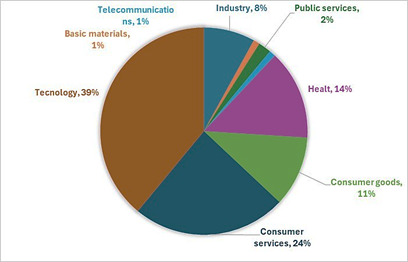
Publicado
Identification of short term Fast-Slow patterns using the Nasdaq-100 future through a technical analysis application
Identificación de patrones Fast-Slow de corto plazo empleando el futuro del Nasdaq-100 a través de una aplicación de análisis técnico
DOI:
https://doi.org/10.15446/dyna.v91n233.112700Palabras clave:
Nasdaq-100, market anomalies, futures market, technical analysis (en)Nasdaq-100, anomalías de mercado, mercado de futuros, análisis técnico (es)
Descargas
In recent decades, the analysis of atypical behavior in asset prices has become relevant, since participants in financial markets recognize that the idea of perfect markets is distanced from reality. The purpose of this research is to present a trading strategy through the identification of short-term chart patterns, based on anomalies in the future price of the Nasdaq-100 index. The historical backtesting methodology will be used in the technical analysis of the asset to quantify the performance of the identified patterns. It will be verified that the anomalies in the stock index are not temporary; rather, they persist and recur on a recurring basis, especially in intraday events. Additionally, the best performing trading session will be determined. This work will provide retail traders with trading guidelines to approach the markets with a statistically profitable strategy.
En las últimas décadas, ha tomado relevancia el análisis de comportamientos atípicos en los precios de activos, ya que los participantes en los mercados financieros reconocen que la idea de mercados perfectos se distancia de la realidad. El propósito de esta investigación es presentar una estrategia de negociación a través de la identificación de patrones gráficos a corto plazo, basados en anomalías en la cotización del futuro del índice Nasdaq-100. Se empleará la metodología de backtesting histórico en el análisis técnico del activo para cuantificar el rendimiento de los patrones identificados. Se comprobará que las anomalías en el índice bursátil no son pasajeras; más bien, persisten y se repiten de forma recurrente, especialmente en eventos intradía. Además, se determinará la sesión bursátil de mejor rendimiento. Este trabajo brindará a los traders minoristas pautas de negociación para abordar los mercados con una estrategia estadísticamente rentable.
Referencias
[1] Farias Nazário, R.T., Lima e Silva, J., Amorim Sobreiro, V., and Kimura, H., A literature review of technical analysis on stock markets. Quarterly Review of Economics and Finance, 66, pp. 115–126, 2017. DOI: https://doi.org/10.1016/j.qref.2017.01.014
[2] Edwards, R.D., Magee, J., and Bassetti, W.H.C., Technical Analysis of Stock Trends,Taylor & Francis Group (ed.). 11th ed., 2018.
[3] Grossman, S.J., and Stiglitz, J.E., On the impossibility of informationally efficient markets. The American Economic Review, [online]. 70(3), pp. 393–408, 1980. Available at: https://www.jstor.org/stable/1805228
[4] Fama, E.F., Efficient capital markets: a review of theory and empirical work. The Journal of Finance, 25(2), pp. 383–417, 1970. DOI: https://doi.org/https://doi.org/10.2307/2325486
[5] Akbas, F., Armstrong, W.J., Sorescu, S., and Subrahmanyam, A., Smart money, dumb money, and capital market anomalies. Journal of Financial Economics, 118(2), 355–382, 2015. DOI: https://doi.org/10.1016/j.jfineco.2015.07.003
[6] Zaremba, A., and Nikorowski, J., Trading costs, short sale constraints, and the performance of stock market anomalies in Emerging Europe. Economic Research-Ekonomska Istrazivanja, 32(1), pp. 403–422, 2019. DOI: https://doi.org/10.1080/1331677X.2018.1545593
[7] Li, Y., Zhao, C., and Zhong, Z., Price discrimination against retail investors: evidence from mini options. Journal of Banking and Finance, 106, pp. 50–64, 2019. DOI: https://doi.org/10.1016/j.jbankfin.2019.05.012
[8] Loughran, T., Linguistic tone and the small trader: measurement issues, regulatory implications, and directions for future research. Accounting, Organizations and Society, 68–69, pp. 38–41, 2018. DOI: https://doi.org/10.1016/j.aos.2018.03.001
[9] Latif, M., Arshad, S., Fatima, M., and Farooq, S., Market efficiency, market anomalies, causes, evidences, and some behavioral aspects of market anomalies. Research Journal of Finance and Accounting, 2(9), pp. 1–13, 2011.
[10] Kuhn, T.S., The structure of scientific revolutions. American Journal of Physics, 31(7), pp. 554–555, 1963. DOI: https://doi.org/10.1119/1.1969660
[11] Tversky, A., and Kahneman, D., Rational choice and the framing of decisions. The Journal of Business, 59(4), pp. 251–278, 1986. DOI: https://doi.org/10.1086/296365
[12] Tua-Pereda, J., La investigación empírica en contabilidad. La hipótesis de eficiencia del mercado (Ministerio de Hacienda-Secretaría General Técnica- SGIDP. 1ra ed.). Instituto de Contabilidad y Auditoria de Cuentas. 1991.
[13] Gultekin, M.N., and Gultekin, N.B., Stock Market Seasonality International Evidence*. Journal of Financial Economics, 12, pp. 469–481, 1983. DOI: https://doi.org/10.1016/0304-405X(83)90044-2
[14] Ariel, R.A. A monthly effect in stock returns. Journal of Financial Economics, 18(1), pp. 161–174, 1987. DOI: https://doi.org/10.1016/0304-405x(87)90066-3
[15] Agrawal, A., and Tandon, K., Anomalies or illusions? Evidence from stock markets in eighteen countries. Journal of International Money and Finance, 13(1), pp. 83–106, 1994. DOI: https://doi.org/10.1016/0261-5606(94)90026-4
[16] Smirlock, M., and Starks, L. Day-of-the-week and intraday effects in stock returns. Journal of Financial Economics, 17(1), pp. 197–210, 1986. DOI: https://doi.org/10.1016/0304-405X(86)90011-5
[17] Brock, W., Lakonishok, J., and LeBaron, B., Simple Technical trading rules and the stochastic properties of stock returns. Journal of Finance, 47(5), pp. 1731–1764, 1992. DOI: https://doi.org/10.1111/j.1540-6261.1992.tb04681.x
[18] Nasdaq Inc. (2018, July 2). NDX vs SPX. Available at: https://www.nasdaq.com/articles/ndx-vs-spx-2018-07-02
[19] Bailey, D.H., Borwein, J.M., López de Prado, M., and Zhu, Q. J., Pseudo-mathematics and financial charlatanism: the effects of backtest overfitting on out-of-sample performance. Notices of the American Mathematical Society, 61(5), 458-471, 2014. DOI: https://doi.org/10.1090/noti1105
[20] Tolun-Tayalı, S., A novel backtesting methodology for clustering in mean–variance portfolio optimization. Knowledge-Based Systems, 209, art. 106454, 2020. DOI: https://doi.org/10.1016/j.knosys.2020.106454
Cómo citar
IEEE
ACM
ACS
APA
ABNT
Chicago
Harvard
MLA
Turabian
Vancouver
Descargar cita
Licencia
Derechos de autor 2024 DYNA

Esta obra está bajo una licencia internacional Creative Commons Atribución-NoComercial-SinDerivadas 4.0.
El autor o autores de un artículo aceptado para publicación en cualquiera de las revistas editadas por la facultad de Minas cederán la totalidad de los derechos patrimoniales a la Universidad Nacional de Colombia de manera gratuita, dentro de los cuáles se incluyen: el derecho a editar, publicar, reproducir y distribuir tanto en medios impresos como digitales, además de incluir en artículo en índices internacionales y/o bases de datos, de igual manera, se faculta a la editorial para utilizar las imágenes, tablas y/o cualquier material gráfico presentado en el artículo para el diseño de carátulas o posters de la misma revista.

















